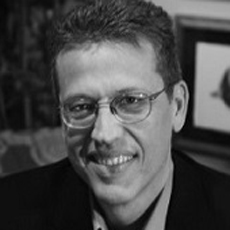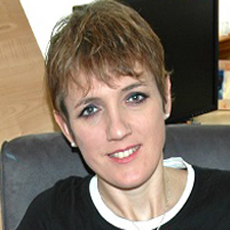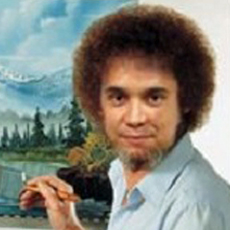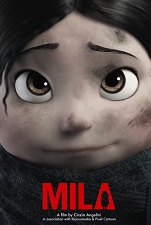 Mila is the story of a little girl who loses her family during the war in Trento, Italy. This is the story Cinzia Angelini wanted to tell via her medium, animation, because of its special connection to her: “This girl, now woman, who inspired me to create this movie, was a child of WWII. She is also my mother.”
Mila is the story of a little girl who loses her family during the war in Trento, Italy. This is the story Cinzia Angelini wanted to tell via her medium, animation, because of its special connection to her: “This girl, now woman, who inspired me to create this movie, was a child of WWII. She is also my mother.”
Mila is at the same time the story of a team – or, one would better say, a family — that expanded over the five past years around a common passion and a common goal. The Mila team is comprised of core groups from four countries: the U.S.A., Italy, Mexico, and the United Kingdom. Professional artists in Italy, Australia, India, France, Belgium, Russia, Indonesia, Malaysia, South Africa, Australia, Argentina, Brazil, Spain and more also contributed in a variety of ways. In all, they have grown to a crew of about 250 – a remarkable group of artists volunteering their time and talent towards this common goal.
This is such an extraordinary story that we, at Animated Views, definitely wanted to tell it and invite you to share that incredible adventure from the most recent release of the trailer to the release of the very film (and, who knows, maybe to the Oscars) with the people who have been experiencing it. Twice a month, we are going to chat with one member of the crew and uncover each time new aspects of the production of Mila.
Now, let’s start with Producer Andrea Emmes. Andrea has been in the entertainment industry for over twenty years as both a performer and in production. Starting in theater, she began her career as a singer/dancer at Walt Disney World, Universal Studios Hollywood, Trinity Arts Center, as a choreographer for Little Kids Dance Party, casting/production assistant for Making The Band: O-Town, and then finally made her way to Los Angeles, CA. After a couple of years working in the video game industry as a production coordinator for Bento Box Interactive and associate game designer for Disney Interactive, Andrea now spends her time as producer for Mila and working as an Audiobook Narrator.
 AnimatedViews: How did you meet Cinzia Angelini?
AnimatedViews: How did you meet Cinzia Angelini?
Andrea Emmes: Cinzia and I met back in March of 2010 at the Art Institute of CA-Hollywood Campus when I was getting my Bachelor of Science degree in Game Art & Design.
AV: How did you become involved in the Mila project?
AE: When I was at the Art Institute, our Academic Director at the time, Lori Hammond, knew Cinzia from when they both worked at Disney Animation and brought Cinzia to teach a Master Class and offer an “in-house” internship that started out every Friday for a month and turned into a 2-year program. I started out as a Production Assistant on the film and now I’m honored to be the Producer. I realized early on that if I wanted to truly succeed and learn all that I could, I would need to take things into my own hands and seek outside opportunities that my classes were not providing me. Meeting Cinzia and coming on board to volunteer on Mila has been life changing. I have been in the entertainment industry for over 20 years as an actor both on stage, onscreen and voice over but I had to put that on hold for a time due to a debilitating pain disorder that I was diagnosed with in 2006 (CRPS).
In going back to college, I needed to find another way that I could “entertain” and share my love for film and performing, and getting the opportunity to help make Mila come to life was exactly what I needed. Everyone that has come on to volunteer on Mila has been welcomed with open arms. That’s why we call ourselves, The Mila Family. From top professionals in the field to aspiring artists, we’re all working hard towards the same goal and I love that there is no ego involved. It’s more about the story. The movement that Mila has come to represent. The fact that we are able to bring together artists from all over the world who might not have ever had a chance to work on a film because of their remote location or because getting into the big studios are so difficult. It’s been inspiring and that’s not something you can turn away from.
In a nutshell, the story and concept was so unique and poignant that I was pulled in immediately. I also was excited about being a part of the biggest online volunteer production, with such high quality, that I knew the challenges would be well rewarded in the end, not only with what I have and will learn but also in just the pride of knowing I was a part of something so impactful.
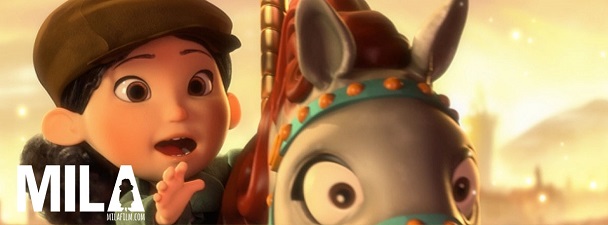
AV: Considering the very specific nature of the project, how would you explain your role as a producer?
AE: Producing Mila is unlike anything I’ve ever done. It’s filled with challenges, both big and small: learning and creating as we go because we’re not working within a “normal” structured pipeline; extremely gratifying to see our ingenuity payoff when we’ve figured out a new way of doing something, like working with artists who live on the other side of the planet and the language barriers; and really inspiring to see all of these amazing people come together because they want to create a beautiful film with a poignant message. It’s just incredible.
For Mila, we all work remotely, in our spare time, nights and weekends so it is extremely different from having your entire team in the same building or room to conduct meetings, explain briefs, go over dailies, troubleshoot problems. It’s forced us in a really wonderful way to find new and creative solutions to working out the “day-to-day” inner workings of making Mila work. I used to try to keep a master and micro schedule, like you would on a normal production, but with people volunteering, it became possible. We really need to be conscious of what each person can offer time wise, work within their schedule and adjust accordingly. It’s not uncommon for us to have to hand off a task, asset, or shot from one artist to another who has to leave the project for some reason.
Another one of the things we try to do for our volunteers, is give back. Because we are 100% volunteer based, Cinzia and myself included, we do not want anyone to feel like we are just taking, taking, taking. No artist wants to “work for free”. We’ve been really lucky to find such talent who can see beyond numbers and share whatever they have to offer for however long they can. Each person’s time and talent is a gift that we cherish. Especially when we first started, we would take on juniors, students and really anyone with the passion to learn so that we could offer them access to our professionals who run our leadership who would mentor, train, encourage and network with them. We want to grow together as artists. Learn from one another. We’ve held many master classes, done portfolio reviews, tips on networking, even been a part of many of our Mila Family members getting amazing jobs at big studios around the world!
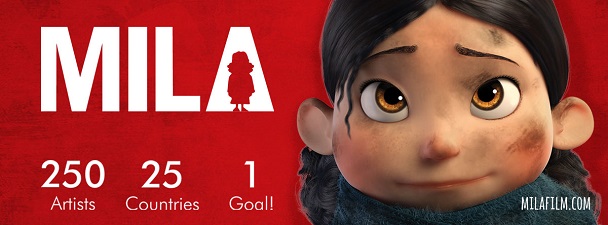
AV: First, you searched for artists, and then the project started to attract people who spontaneously volunteered. Can you tell me about that adventure of constructing your crew?
Like I mentioned, when Cinzia began to set out on her own with Mila, we started at the Art Institute creating models and textures with the Media Animation & Arts and Game Arts & Design students. At this time, and this is a better question for Cinzia to expound upon, but our VFX supervisor is in Italy and one of our Executive Producers is in the UK. So they started to look for people in their area and time zones and it just kept growing from there. We were looking in forums, Craigslist, Facebook, you name it, we were looking and people just began to flock to us. Besides word of mouth, we also use Zerply.com to find professionals and that has been a life saver.
We started to ask our team “Why Mila?” and hearing some of their stories and reasons are mind blowing. Some of them have grandmothers who survived WW2 and want to pay tribute to them, others wanted to learn and grow as an artist, others heard us on a podcast or saw an article written about us and was inspired that so many people were volunteering for this and others were amazed at how high quality were are able to achieve that they reached out and asked how could they get involved. Mainly, to be honest, once we were starting to get some press, outside of word of mouth, people were inspired by the story of this little girl who survives losing her mother in a bomb attack and survives and eventually thrives. It’s the movement that people are attracted to. It’s the power that a film has to make a difference, start conversations, to inspire, amaze and touch others that has brought people to us. That makes it that much easier to wake up every day early to work on Mila or stay up late so that I make sure that I am available to every time zone, so that I can give back tenfold to what our family is giving to us.
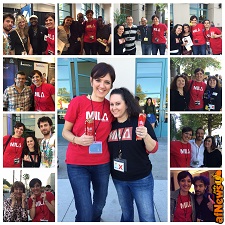
AV: What do the artists tell you about that experience?
AE: Great question. Here’s just a few of the reasons our Mila Family shared with us:
“The opportunity to join the project arose in April 2011 through a mutual friend, Andy Gahan (one of Mila’s Executive Producers), who introduced me to Cinzia and the world of Mila. At the time, I was at University and starting off within the fascinating world of Production Management and the project allowed me to develop my skills and learn new software on a live project.”
Neil Penlington – Production Manager (UK)
“Despite knowing nothing about Mila‘s content before being invited to interview, I was drawn by the fact that it’s a passion project made up completely of volunteers. I knew it would be an awesome experience to work with professionals who donated their time and talent simply due to their love of the art of animation.”
Erin Lindeke – Production Coordinator (LA, CA)
“The idea of collaborating on a project with such amazing potential will always be intriguing. But something of this scale, with such a diverse crew that literally spans the globe, couldn’t have even been considered a few years back. It’s an amazing time we’re living in, and this Mila project is a testament to that.”
Kirk Parrish – Visual Development (Seattle, WA)
“My family has been a part of the Armed Forces since WW1. My own father was a soldier, I grew up around refugees that became like a second family to me (I ate with them, learned their language and even found things in common). My mission with studying Neuroscience with applied Musical Theory is to one day be able to treat war vets and/or civilians with mood disorders, PTSD or degenerative diseases like Alzheimer’s or dementia with the universal code that is music.”
Zoe Filomeno – Production Assistant (Puerto Rico)
“I have been looking for a project to get behind that stood for something bigger than anything I had worked on in the past, and when I heard Cinzia’s story and saw how beautiful this project was I couldn’t help but ask if I could help out in some way.”
Mitch Bowler – Marketing Manager (Winnipeg, Canada)
“I saw an article about Cinzia and I saw some images from Mila! I loved the style, I thought it was really beautiful and sophisticated looking. When I read what the story is about, I was sure I wanted to be part of that film somehow.”
Alexandra Kavalova – Art Director (Canada)
“What drew me to join Mila, is the idea of being a part of the collaboration of all those people from all over the globe, around an abstract idea, only passion and desire for telling a story that they believed in, in such a high quality as a goal. It’s such a unique experience, as a project on the side, and working with such a bunch of people who dare to dream, it’s an honor for me to be part of it.”
Ahmed Adel – Junior Animator – (Egypt)
“A few years ago I was looking for some challenging project to work on during my free time, but at the same time I wanted to work on something that could have become visually impressive and Mila looked very promising”
Mattias Lullini – Modeler (Italy)

AV: The Mila team is presented as a “virtual studio”. Can you tell me about the international structure of your crew?
AE: We started out having the majority of our crew – our family – in the US, Italy, Mexico and the UK. But now we’ve grown to over 25 countries. Everyone works from their home, whenever they have time and just puts in the hours that they can. We communicate using so many different online services like Google Docs, Slack, our own privately run forum, email, and Skype. Like any production we are broken up into departments. Right now, since we’ve wrapped on Modeling, Textures, and Rigging, we’ve got Layout, Lighting, CFX, FX, Look Dev, Animation, and End Credits left to complete. Each department has a supervisor and they basically take care of their department and I come in with my production team as needed, to find people, keep track of assets or shots, etc. It’s astounding really when you think about it and Cinzia and I almost get giddy when we bring on a new volunteer from a country that isn’t represented yet. My ultimate bucket list would be to have at least one person volunteering on Mila from every country. How cool would that be! Talk about Artists Uniting!
AV: What are the challenges and richness that such a virtual studio implies?
AE: Communication and being able to keep hard deadlines is a challenge. Because we are a volunteer based project, we can’t be overly demanding on our team since they are using their valuable “free” time to work on Mila while they have their day job and regular life that has to fit in there. It’s a struggle with having to send kind reminders or find other ways to help them move along or split up tasks if needed. Since we don’t meet in the same office building and most of our team lives on the other side of the world, we rely heavily on email communication. There is always a lag of a day or two though sometimes peoples’ emails will get flooded or they forgot or other things in their life take precedent and we get shelved.
The best way to deal with communication issues is for me to be consistent in my approach, be kind and understanding but know when I need to either move along and reassign a task or shot to someone else who has time or just keep being everyone’s cheerleader. It’s important that everyone on my team understands how valuable they are and how grateful we are for their time and talents. Even if they only do one asset or 12.
Another issue is when there are errors in scripts or with a model or rig, not being able to get together in one room to troubleshoot or see what the other is doing so we can address and fix things quicker. A lot of this is figuring out as we go, so there is a learning curve that we battle with but in the end, because we have our team members all over the world, there is no such thing as an easy fix.
The great thing though is that we have access to so many great people with such a wealth of knowledge that when an issue arises, someone is always available to see if they can fix it or find someone who can, look it up, etc.
AV: Can you tell me about the tools, process, methodology you had to use to coordinate all these people? Did you have to invent new ones?
AE:I use Google Docs and Spreadsheets to death! They make it so much easier for everyone to view and see our “Tracker”, to see the status of shots, assets, etc. any time that works for them and be able to adjust on the fly, have the supervisors update their tabs for their departments so it’s all up-to-date.
I’ve learned to multi-task more so then ever and be flexible because one person works best using one form of communication like email only and others can’t stand it because it’s too hard to keep track of, so we’ve gone through many different ways to accommodate different people. If we were in the same “studio” everyone would have their work email so things wouldn’t get so hectic. Cinzia and I get hundreds of emails a day, plus messages in over 100 channels in Slack that we have to keep up with, so mastering time management is key. I’m a big fan of lists.
I’ve not invented any new tools, but just learning who your team is, how they work and being flexible and ready to pivot as needed is the real key. And keep meticulous notes because there are so many people involved around the world that it can get a bit messy paperwork wise if you’re not careful from keeping track of emails, NDA’s, where people are from for time zone issues, etc.

AV: In addition to the technological and communication challenge, I imagine that adventure is a huge human one. Can you tell me about that aspect of your journey?
AE: That is a great question. Many times technology is a blessing and other times it’s an absolute curse because software will glitch, you’ll have crashes and lose work or have to write an intricate script to optimize workflow. So it’s good to be surrounded by people who are experts in their field. I think dealing with any large group of people you’re going to find a variety of different personalities that you must learn and adapt to, especially when dealing with different cultures and some language barriers. Even though everyone that works on Mila speaks and writes English, 85% of the Mila family has English as their second language so sometimes it can get tricky when trying to get the right idea across. So it just takes patience. You can never make all people happy all of the time. So you just do the best that you can do. We give promotions when deserved, to help out not only with our project, but with the artists’ resumes and credits, and also in hopes to show them the much due respect that we feel they deserve. When we can and are in an area where a lot of our crew lives, like in Southern California, then we’ll try to have a dinner or get together, just to hang out and be people. Since 90% of our Mila Family lives far from me, I’ve only spoken to them in text form whether it’s through email, social media or Slack, but I feel really connected to them as if I ran into them today in person, we would hug and laugh like old friends. That’s one of the most amazing things about this project is the connectivity that we have with colleagues and new friends around the world.
AV:At what stage of the production are you now? What are your present goals and needs?
AE: Very exciting, we just released our new trailer which is gorgeous. I am so proud of everyone on the team from the beginning who were modeling and texturing, to everyone in the present that pushed hard to make the trailer happen! Now we’re full steam ahead finalizing Layout and getting shots completed in Lighting and Animation, and working on our End Credits. We still need a lot of help in Character FX and FX right now so we’re still on the lookout for senior artists who have a passion for this and would love to join us in our journey!
May 10th, 2016 we are starting our Indigogo campaign in order to raise $60,000 to help with our rendering costs and to help with licenses so our team has the best that they can work with. Animation is expensive and we’re working at a really high quality level so we really need help to make that happen. As you can see with our trailer, we can do some amazing things with no budget and volunteers who are passionate about what they do. Now we just need that extra push to get to completion.
We’re running our ThunderClap contest right now, which anyone with a Facebook, Twitter and/or Tumblr account can join in to support us. When you join in, ThunderClap will post once on May 10th about the launch of our Indiegogo campaign to your social media(s) of choice. It really helps us reach as many people as possible. For everyone that joins our ThunderClap, they will be entered to win a Mega Mila Prize Pack. Here is the link: goo.gl/2nP3Io
We have a lot of other contests in the mix and a fun Mila Fan Art campaign coming up on social media after our Indiegogo campaign and then it’s just continuing to work hard and get the film finished so we can start rendering and have it completed by 2017 and hit the festival circuit.

AV: Thanks a lot, Andrea!
AE: Thank you so much for allowing me to share about Mila. It’s such a labor of love and something that I’m so proud of. Our Mila family is amazing and Cinzia and I are so grateful to everyone involved from our volunteers, our sponsors, our family and our fans!
For more info, please go to:
www.milafilm.com
www.whoismila.com
See the Mila Trailer on YouTube: goo.gl/g9lJtK
For updates on Mila: goo.gl/xD01AD
Or check them out on Facebook: goo.gl/A2BtId
Our warmest thanks to Andrea Emmes and Cinzia Angelini!





